Identification and Treatment of Common Pest and Disease Problems in the Residential Lawn
Being able to identify common pest and disease problems is an important part of maintaining a healthy and visually appealing lawn. In order to identify common pest and disease problems in the residential lawn, it is important to be able to identify what type of turf grass mix your lawn contains. The three most common types of grasses used in the northern part of the United States are Kentucky Bluegrass, Perennial Ryegrass and Tall Fescue, which is often mixed with Bluegrass and Perennial Ryegrass. When you have identified which type of grass you have, you can more readily identify which disease your lawn may be infested with, since each variety tends to have its own diseases and pests.
Lawn Diseases
Affecting all 3 types of Grasses
Gray Snow Mold
Symptom: This mold commonly has a gray, gel-like appearance. Spots are approximately 12” in diameter.
Time: Late winter, early spring
Damage: Mats down the grass; if severe enough, it will leave a brown, dead spot.
Cause: Often the result of poor late-season mowing practices, because long grass in the winter harbors this disease
Treatment: Grass should be cut to proper length before it goes into dormancy in northern climates. This is the easiest and most economical way to prevent this disease, but it can also be prevented using a preventive systemic lawn fungicide.
picture unavailable
Fairy Ring
Symptom: Mushrooms growing in a circular band on the lawn in the spring and summer. Diameter can be from 1- 12’. Within the band, the grass is darker green than the rest of the lawn
Damage: Unsightly, and can kill the grass within the band
Treatment: Fertilize the lawn well and kick the mushrooms down

Fairy Ring
Department of Crop &
Soil
Sciences at Penn State
Affecting Cool Season Grasses
Leaf Spot
Symptom: Prominent black oval spots on the blade of grass
Time: Shows up in early May and late August
Damage: Thinning of the turf over several years if not treated
Cause: Associated with high humidity and low mowing heights (1.5” or less)
Treatment: Can be prevented by following good lawn-cultural practices. This means mowing at a height of 2.5 – 3 inches and irrigating during the early morning hours, from 5:30 to 10:30 A.M.

Leaf Spot
Plant Disease Diagnostic
Lab at Kansas State
Red Thread
Symptom: Can be identified by its fuzzy pinkish red threads and is usually found in patches less than 12” in diameter
Time: Most commonly found in the spring and in the fall months
Damage: If severe enough, could kill the grass
Cause: Often a result of long grass, improper fertilization and water- soaked lawns
Treatment: Can be prevented by mowing at proper heights, implementing a sound fertilization program and by proper irrigation.

Bag Worm
Department of Entomology
at Purdue University
Pink Patch
Symptom: Very similar to Red Thread but lacking the fuzzy threads. It simply appears as a pink circle.
Time: Spring.
Treatment: Can be prevented using the same practices used to prevent Red Thread (see above)

Pink Patch
Fusarium Blight (also affecting Bluegrass and Perennial Ryegrasses)
Time: Summer
Damage: If not treated, will eventually kill the infected spot of turf
Cause: Common in lawns that are compacted or have heavy thatch (decomposed grass matter). The disease begins small but begins to spread when daytime temperatures are 90◦ F and when nighttime temperatures are above 70◦ F.
Treatment: Proper irrigation and fertilization are the main ways to prevent this disease.
picture unavailable
Pythium Blight
Symptom: Cotton-like substance on a slimy, matted turf
Time: Summer
Damage: Mats down the grass and could eventually kill it
Cause: Excessive fertilization and excessive moisture. It is also commonly seen when daytime temperatures are between 80 – 95◦ F and when nighttime temperatures are above 70◦ F for three consecutive nights.
Treatment: Can be prevented by implementing a sound fertilization program and by proper irrigation
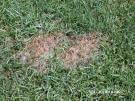
Pythium Blight
Department of Plant
Pathology
at the University of
Wisconsin – Madison
Affecting Kentucky Bluegrass
Dollar Spot
Symptom: Shows itself as a spot in the lawn about the size of a silver dollar in late May to early June. With closer inspection of the grass blade, a reddish-brown hourglass-shaped spot can be seen.
Damage: Will eventually kill the affected area of turf
Cause: Often the result of excessive thatch and poor fertility
Treatment: Excessive thatch and poor fertility can be prevented by proper fertilization, which involves applying enough nitrogen to give the lawn a green vigorous appearance, without applying too much.
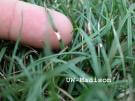
Dollar Spot
Department of Plant
Pathology
at the University of
Wisconsin – Madison
Rust (also affects other types of lawns)
Symptom: Can be identified by its rust colored spots that easily rub off
Time: It often shows itself in the late summer in dry conditions
Damage: Not really seen as a major problem other than the inconvenience of turning a home owner’s shoes orange when walking through the lawn
Cause: Warm days, cool nights and slow drying of the lawn
Treatment: For prevention, mow frequently and properly. If the rust is severe, implement a systematic fungicide, as well as catch and discard grass clippings when you mow.
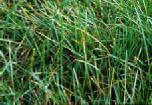
Rust
Plant Disease Diagnostic
Lab at Kansas State
Lawn Pests
Identifying common lawn pests is just as important as identifying common lawn diseases. Pests fall into two major groups: Insects and Weeds.
Insects
The five major insects that effect lawn turf are Japanese Beetles, the Northern Masked Chafer, May Beetles, Sod Webworms and Army Worms.
Japanese Beetles, Masked Chafers and May Beetles. The larvae or grubs of these insects eat through the root crown of the grass. Dead patches of grass will appear, and patches can easily be pulled up in chunks. The grubs are usually visible under the removed turf. Often skunks and raccoons will damage lawn turf searching for grubs as a food source. Damage from May beetles is commonly seen in mid-summer whereas Japanese Beetle and Masked Chafer damage is commonly seen in late summer into fall.

Northern Masked Chafer
Center for Urban Ecology & Sustainability at theUniversity of Minnesota

Grub
Copyright © 2005
Purdue University
Sod Webworm (larva of lawn moths)
Symptom: Roughly three-quarters of an inch long and having stiff hairs running along its body. This insect typically affects Bluegrass species.
Time: Mid-May and at the end of August
Damage: Chews through the root crown of grass and spins silk-like webs in the thatch, possibly resulting in death of large sections of the lawn

Sod Webworm
The University of
Minnesota
Extension Service
Army Worm
Symptom: Roughly 1.5 inches long, green and has several strips on its side. Skeletonized grass blades
Time: Spring
Damage: Unlike the other insects, this worm actually eats the blade of the grass instead of its root system. Although it’s not usually a major problem, if severe enough, it can cause death of patches of the lawn.

Army Worm Damage
Copyright © 2005
Purdue University
Weeds
Weeds are the second lawn pest. Did you know that a weed is defined as any plant that is unwanted in a certain area? For example, a corn stalk would be considered a weed if it were growing in the middle of your lawn and turf grass would be considered a weed if it were growing in a corn field. Weeds in lawn fall into three main groups: Grassy weeds, Annual Broadleaf weeds and Perennial Broadleaf weeds.
Grassy weeds include Crabgrass and Annual Bluegrass. Crabgrass can be identified by its flat crab-like appearance whereas Annual Bluegrass can be identified by its boat-shaped tip and its ability to produce seed heads even when mowed at heights less than one inch. Both of these grassy weeds are annuals, meaning that they complete their lifecycle within one growing season. The best control for these weeds is an application of a granular pre-emergent herbicide in late-winter or early spring.
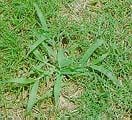
Crabgrass
University of Florida
Environmental
Horticulture Department
Annual broadleaf weeds are another common group of lawn weeds. This group includes Black Medic, Yellow Woodsorrel and Common Chickweed. Black Medic can be identified by its trifoliate leaves (containing three leaves), its clover-like appearance and its small yellow flowers. Yellow Woodsorrel is also trifoliate, but the leaflets are heart-shaped and have yellow trumpet-like flowers. Finally, the Common Chickweed can be identified by its shiny leaves, hairy stem and its small, white five-petal flowers. These weeds can be controlled easily by using any common selective Broadleaf Herbicide or by hand pulling.
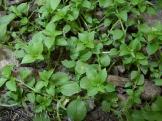
Common Chickweed
Plant Pathology
Extension
of Iowa State University
Perennial Broadleaf weeds include Mouse Ear Chickweed, Canada Thistle, Plantains and Dandelions. These weeds are considered perennials because they live longer than one growing season and can reproduce multiple types.
Mouse Ear Chickweed is a low-growing weed that reproduces by creeping roots. It can be identified by its hairy stem and leaves as well as by its small, white flowers. This weed can be easily controlled by hand pulling because of its shallow root system, but chemical means are preferred.
picture unavailable
Canada Thistle is a very common weed in the lawn and landscape. It can be identified by its light-green, notched and slightly spiny leaves. This weed is one of the most difficult to eliminate due to its large horizontal root system. It is recommended that you use only chemical means to control this weed, because hand pulling usually does not remove the whole root system, which results in the growth of two weeds in the same location as the previous weed.
picture unavailable
Plantains can be identified by their low growing habit (form) and strongly ribbed leaves. The greatest characteristic by which they can be identified, however, is their flower that is borne on a long flower stalk in mid-summer.
picture unavailable
The Dandelion is probably the most common weed found in the residential lawn. It can be identified by its low growing habit, large tap root and, of course, its bright yellow flower seen typically in the spring. This weed seems to be the most hated weed by most homeowners due to its ability to reproduce quickly and abundantly. The best way to control this weed is to apply a selective Broadleaf Herbicide in the fall; hand pulling is not recommended due to the Dandelion’s large tap root.
picture unavailable